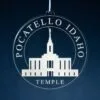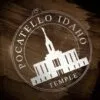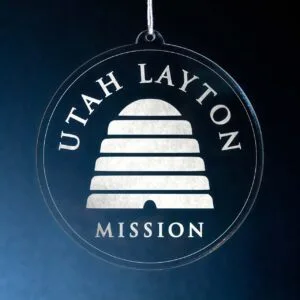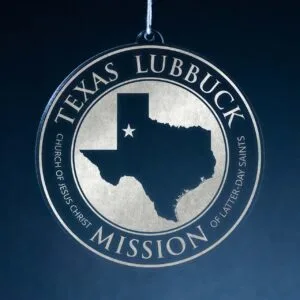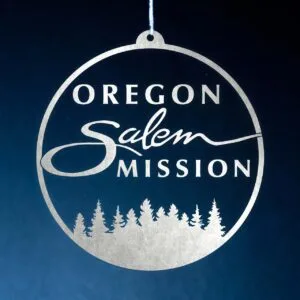Pocatello Idaho Temple Christmas Ornament
$17.99 Original price was: $17.99.$13.99Current price is: $13.99.
Let this ornament bring your family close together around the tree to ponder the miracle of the Pocatello Idaho Temple.
| Material | Transparent Acrylic |
| Construction | Laser Etching |
| Length | 4 Inches |
| Width | 3 7/8 Inches |
| Weight | 0.8 oz |
| Shipping | Usually ships within 1-2 days |
| Returns | Within 30 days of purchase |
Product Description
Made out of a lightweight and very durable transparent acrylic, this ornament will not weigh your tree down and can definitely withstand being dropped by the little ones should they get too curious around the tree. The acrylic is cut into a 4 inch circle and then laser etched with the name of the temple and a graphic depicting an artistic representation of the Pocatello Idaho Temple.
Get one for your loved ones to remind them that families can be together forever!
Temple Information

Address
Pocatello, Idaho 83201-1828
Dedicated
Size
Temple Locale
The 195-foot tall Pocatello Idaho Temple sits high on the city's east bench just east of the stake center for the Pocatello Idaho Highland Stake. The beautiful granite walls are easily visible to motorists traveling Interstate 15 or Interstate 86, especially at night when lighting illuminates the exterior structure and the stained-glass windows. The temple grounds have nearly 500 trees and tens of thousands of plants and flowers. A plaza is located on the north side where bridal parties may gather.
Temple Facts
The Pocatello Idaho Temple was the sixth temple built in the state of Idaho, following the Idaho Falls Idaho Temple (1945), the Boise Idaho Temple (1984), the Rexburg Idaho Temple (2008), the Twin Falls Idaho Temple (2008), and the Meridian Idaho Temple (2017).
Pocatello had been considered for the first temple in Idaho in the 1930s, but bringing water to the proposed hillside location was an obstacle.
In the chapel of the Pocatello Idaho Temple, there is an art glass grouping depicting Jesus Christ holding a lamb. It was salvaged from a church in the eastern United States and restored for use in the temple.
Temple History
Announcement
When the Pocatello Idaho Temple was announced on April 2, 2017, there were 11 stakes in the Pocatello-Chubbuck metro area with another 10 stakes located in the surrounding communities of American Falls, Arimo, Blackfoot, Grace, McCammon, and Soda Springs. An extensive renovation project of the Idaho Falls Idaho Temple had just been completed, which reduced the seating capacity from 140 to 88.
Temple Site
On April 6, 2017, four days after the announcement of the Pocatello Idaho Temple, the future temple site was annexed into the City of Pocatello as part of a larger land annexation, though the temple location had not yet been announced.
On June 22, 2017, state approval was granted for the construction of a new I-15 interchange to be built north of Pocatello, which would provide better access to the Pocatello Idaho Temple. Construction of the Northgate interchange began on November 5, 2018, and it opened on December 6, 2019.
On November 15, 2017, application for the subdivision where the Pocatello Idaho Temple would rise was considered at a City of Pocatello Planning and Zoning Commission meeting. Applicants included the Church, the developer, and the engineering firm. The nearly 29-acre subdivision was presented including the 11-acre temple site and 31 surrounding residential lots. A proposal to rename Ray Street to Monson Street was also included in the application. The name would honor President Thomas S. Monson who announced the temple. The Commission unanimously recommended approval of the subdivision to the City Council. The Council's approval was granted on February 1, 2018. Construction of the subdivision infrastructure began the following month and concluded in the fall of 2018.
On September 7, 2018, the site location for the Pocatello Idaho Temple was officially announced in a news release from Church headquarters that included an exterior rendering, revealing a white three-story building with a multi-tiered central spire—complementing the familiar architecture of the historic Idaho Falls Idaho Temple where Pocatello-area members had attended temple services for decades.
Government Approval
On October 11, 2018, a Church representative presented two variance requests at a City of Pocatello Hearing Examiner meeting to allow construction of the Pocatello Idaho Temple. The first request was a variance from the height restrictions, and the second was a variance from the lighting standards. The Hearing Examiner approved both the height variance and the lighting variance with the condition that the nighttime floodlighting be turned off by 10 p.m. each night.
Renderings
On March 1, 2019, renderings of the interior and exterior of the Pocatello Idaho Temple and site plan were on display at a neighbor open house held at the stake center west of the temple site. The previous evening, representatives from Church headquarters held a briefing with local Church leaders and conducted interviews with the media.
Groundbreaking
Over 2,500 eager Pocatello-area youth descended on the temple site on March 5, 2019, with shovels in hand to clear the Pocatello Idaho Temple site of vegetation in preparation for the groundbreaking ceremony. With so many helpers, all of the weeds and sagebrush were pulled from the 11-acre site in less than 30 minutes.
In answer to many prayers, sunshine and beautiful blue skies accompanied the Pocatello Idaho Temple groundbreaking ceremony on Saturday, March 16, 2019, despite weeks of gray clouds and heavy snowfall. The opening prayer was offered by hometown hero, Taysom Hill, who is a quarterback for the New Orleans Saints but put on his jersey for the Latter-day Saints on this occasion. Elder Wilford W. Andersen of the Seventy presided at the ceremony and offered the dedicatory prayer. Church and community leaders, local developers, and numerous interfaith leaders were the first to turn the ceremonial shovelfuls of dirt.
Open House
During the five-week public open house of the Pocatello Idaho Temple, the number of guests who toured the interior of the building totaled 250,721.
Dedication
Elder Neil L. Andersen of the Quorum of the Twelve Apostles, who grew up in the Pocatello area, accompanied President Ballard to the dedication of the Pocatello Idaho Temple. "I had a beautiful childhood here from the time I was just about 4 or 5 until the time I left on my mission and came back, so it has great memories for me," said Elder Andersen. "I'm so happy to see it is a magnificent temple on the hill. It's no small temple. And you can see it from almost everywhere in the valley."1
President M. Russell Ballard, Acting President of the Quorum of the Twelve Apostles, dedicated the Pocatello Idaho Temple in three dedicatory sessions on November 7, 2021, making it the 170th dedicated temple in operation. He prayed for the families and individuals of the temple district saying, "Wilt Thou prosper them and grant them the righteous desires of their hearts. Bless them to be faithful and true to the covenants they will make in Thy holy house. We ask Thee to touch the hearts of the youth and the children, that they will feel Thy love for them as they visit this sacred place and walk the grounds and serve within."
Temple Design
Exterior
The exterior cladding is a light gray granite called temple white and is supplied by Best View in Fuzhou, China, and installed by IMS Masonry of Lindon, Utah. It is sandblasted to achieve the lighter finish. The height of the temple measured at the parapet above the third floor is 68’10”. The height to the top of the tower is 182’. The height to the top of the angel Moroni is 194’6”.
FFKR Architects designed the art glass with technical assistance from Glass Images in Orem, Utah. The art glass features wildflowers of the Idaho mountain desert including the syringa, which is the Idaho state flower, and the bitterroot. The colors in the art glass are sage, representing the sagebrush of the region; gold, representing the wild grasses that turn gold in the summer; and pink and coral, representing the sunset, the bitterroot flower and Red Hill above Pocatello. The fabricator is Holdman Studios located in Lehi, Utah.
The landscaping has been arranged in a series of formal planting areas featuring a linear arrangement to complement the temple. The plantings have a vertical hierarchy that ascends toward the temple. Plantings were selected for their seasonal interest, beautiful flowering patterns, ability to attract pollinators such as butterflies and suitability for the local climate. The most common trees on the site are the Norwegian sunset maple, sawleaf zelkova and Dolgo crabapple. The shrubs used on site were selected for their bright flowering colors, such as English lavender, snowberry and snow queen hydrangea. Around the perimeter of the site will be a combination of white firs, alpine firs and lodgepole pines, which were selected from the trees growing in the mountains around the area. FFKR Architects of Salt Lake City, Utah, is the landscape architect.
Interior
The carpet and rugs have a design that is congruent with the other motifs and design elements in the temple. There are circles, octagons and raking (striped) elements supplemented by florals that are indigenous to Pocatello. These are the Indian paintbrush, bitterroot and syringa. Colors selected of greens, golds and corals are representative of the natural colors of Pocatello landscape and botanicals.
The main stone, luna beige, is quarried out of Bethlehem, Israel. The countertops and font in the general building use Sahara gold, quarried out of Pakistan. Two accent stones are used as details in the floors and restroom counters: a green stone called costa esmerelda (a granite from Iran) and a red stone called rojo alicante (a marble from Spain). The bride’s room uses two accent stones, sakura (a marble out of Turkey) and arandis (a granite out of Namibia). The celestial and sealing room marble is called crema ella and is quarried in Turkey.
The decorative painting uses all the same colors of green, yellow and coral, with gold added. The leaves and pedals of syringa, bitterroot and Indian paintbrush are supplemented by geometric lines and cut back/rounded corners. All the decorative painting is applied to ceilings and woodwork to accent and highlight woodwork designs and was painted by David Horne of Sandy, Utah.
The chapel has a historic art glass tri-part depiction of the Savior with sheep. It was salvaged from a church in the eastern United States and has been restored. It was created by Frank Drehobl and Sons Art Glass in Chicago, Illinois, and restored by Holdman Studios in Lehi, Utah.
Standard fixtures are made of antique brass and glass, with crystal added in the ordinance rooms. A syringa flower is featured in the rounded corners. The celestial and sealing room fixtures were designed similarly but entirely in brass and crystal fabricated by HB Architectural Lighting in Bronx, New York, and installed by Wheeler Electric of Idaho Falls, Idaho.
The general wood species is quartered cut sapele with some accent panels in figure cut crotch mahogany, stained to match the sapele. These panels are in the front of the recommend desk as well as the pulpit in the chapel and the instruction room altars. The millwork was fabricated and installed by Boswell Wasatch Architectural Woodwork of Springville, Utah.
The baptismal font railings are a standard stock aluminum construction with custom decorative panels with an antique brass inspired finish. There are accent panels that present the leaves of the syringa and petals of the bitterroot flowers, local elements to Pocatello. In railings outside the font area the top cap and hand railing are made of sapele and fabricated by Smith Design of Gunter, Texas.
The door panels are a standard-style rail with a recessed wood panel or art glass. The doors are of sapele of the Congo River region and are fabricated by Marshfield Door Systems of Marshfield, Wisconsin, and installed by Beacon Commercial Door & Lock, located in Salt Lake City, Utah. The finish is antique brass in the general temple and brass in the sealing and celestial rooms.
All ceilings are either standard drywall construction, catalogue acoustic ceiling panels or a combination of both. All administration suites, dressing rooms and other secondary spaces have acoustic panels. All drywall ceilings have a crown molding added that is a painted maple, poplar or similar wood. The ceilings are installed by Ed’s Painting Contractor, Inc., of Blackfoot, Idaho.
The temple’s original artwork includes “Aspen Grove” by Michael Coleman; “Peaceful Morning” and “And the Evening, and the Morning Were the Fifth Day” (Genesis 1:23) by Leon Parson; “For the Strength of the Hills” and “Haystack Mountain” by Ken Spencer; “Mink Creek” and “Scout Mountain Vista” by Ken Stockton and “Not Alone” by Minerva Teichert.2
Temple Background
In 1930, when President Heber J. Grant announced that the next temple of The Church of Jesus Christ of Latter-day Saints would be constructed in Idaho, leaders from various stakes throughout the state urged that their respective communities be considered for the honor. Ezra Taft Benson, who was a counselor in the Boise Stake presidency, presented a particularly stirring argument for the state capital to be considered.3 In time, however, a hillside site was seriously investigated in the booming railroad town of Pocatello. The community's surrounding mountains made a beautiful setting for a temple in a city with excellent interstate transportation and a growing population—the second highest in the state at the time. However, a depression-era economy had left the local government so poor, it would not pay to extend water and utilities to the west-bench location.4 In the meantime, the Chamber of Commerce in Idaho Falls, located 50 miles north of Pocatello, donated a prime parcel of land on the banks of the Snake River, bordering an LDS hospital. And that became the site of Idaho's first temple.
As the years passed, Pocatello experienced a series of economic setbacks, producing a local quip among members that the city was "cursed" for passing on the temple. Nevertheless, the hope never died for a House of the Lord to be constructed there. Decades after Idaho's first temple was constructed, a second temple was announced in 1982 for the state capital, the Boise Idaho Temple. In 1998, land on Pocatello's east bench was secured by the Church for the anticipated purpose of building a temple. However, it was the Rexburg Idaho Temple that was announced in 2003, two years after the announcement that Ricks College would become Brigham Young University–Idaho. And months later, the Twin Falls Idaho Temple was announced to serve members in the South Central region of the state. Pocatello Saints patiently waited through the perennial speculations and rumors. In 2011, the Meridian Idaho Temple was announced as the fifth for the state to serve the rapidly growing Boise metro area. Other communities near Pocatello also received temples including the Brigham City Utah Temple and the Star Valley Wyoming Temple. The Saints of Pocatello rejoiced in each new temple, grateful that faithful Saints would be spared difficult travel.
In 2017, Pocatello's long-awaited dream took one step closer to reality. The city had been placed on a long list of potential temple locations produced by the Temple Department that was presented to the prophet, President Thomas S. Monson. When Pocatello was mentioned, he stopped the presenters and said: "Pocatello will get a temple. The Saints there are well prepared, and it's time for them to have a temple."5 On April 2, 2017, President Monson himself made the announcement during the Sunday Morning Session of General Conference. Shouts of joy rang in living rooms throughout the valley, and tears of gratitude were shed. Pocatello would receive its temple.
Related Products
Related products
-
Sale!

Utah Layton Mission Christmas Ornament
$18.98Original price was: $18.98.$16.98Current price is: $16.98. Add to cart -
Sale!

Texas Lubbock Mission Christmas Ornament
$18.98Original price was: $18.98.$16.98Current price is: $16.98. Add to cart -
Sale!

Oregon Salem Mission Christmas Ornament
$18.98Original price was: $18.98.$16.98Current price is: $16.98. Add to cart -
Sale!

Oklahoma Oklahoma City Mission Christmas Ornament
$18.98Original price was: $18.98.$16.98Current price is: $16.98. Add to cart




